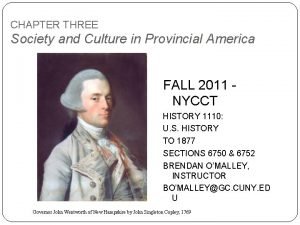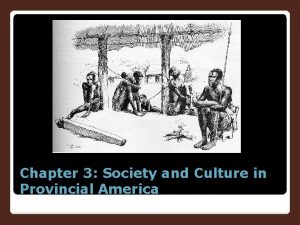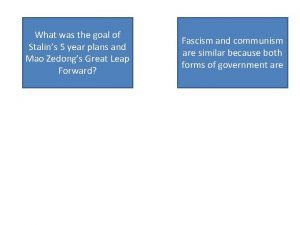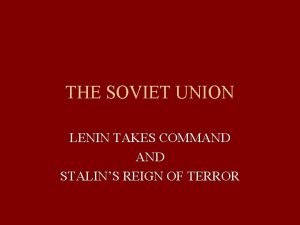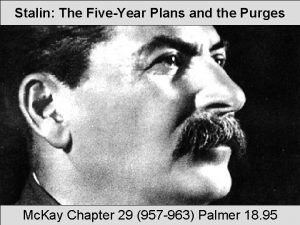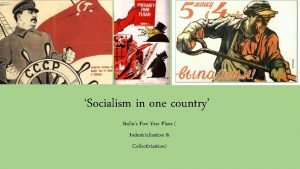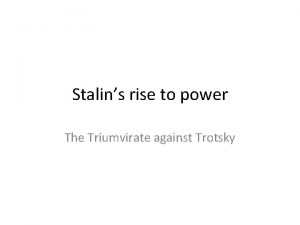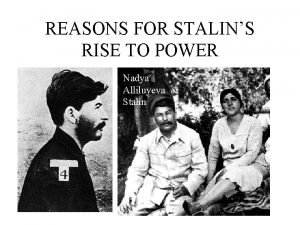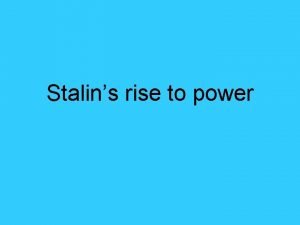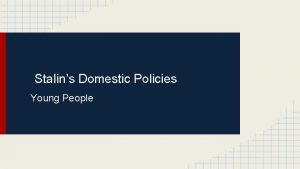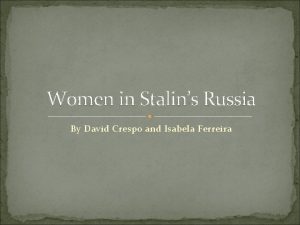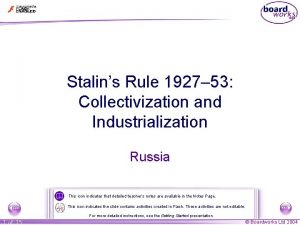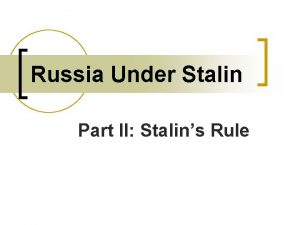Chapter XI Society and Culture in Stalins Russia









- Slides: 9

Chapter XI: Society and Culture in Stalin’s Russia According to Marx, all inequalities of wealth and power will be swept away in a new classless society based on equal distribution of wealth. But was that the situation in Russia in the 1930’s? Many Communists from outside Russia were shocked by what they saw. Between 1921 and 1941 over 18 million people left the collective farms to move to cities for better paying jobs.

Religion • What was Marx’ take on religion? • The Communists too believed that the religion served as a distraction to escape the harsh realities of life and kept people poor and oppressed. • The attacks on churches and monasteries. • Read p. 205 for more details.

Education for the Future • By 1939 illiteracy had declined to only 4% for males and 18% for females. • New progressive ideas such as: no more exams and competition. • Classical education was under attack and replaced by vocational training. • Attack on professors and the need for a proletarian background.

• • By 1935, tests and exams are reintroduced Compulsory uniform. Less emphasis on proletarian background. But everyone must study Marxism-Leninism. Joining the young pioneers up to 14 years of age Then Komsomolsk until 28. Young Communists were supposed to be the role model for all youth. Any similarity with Germany in 1930’s?

• The story of Pavlik Morozov on p. 210 FAMILY LIFE Marriage as bourgeois institution and sexual liberation. Read p. 210 for more details. Housing problems. Three generations living together, often different families live together as well. In 1936 abortion is made illegal and homosexuality was banned as well.

• Crèches for working mother to encourage rapid return to work. • Look at S. 11 on p. 212. What idea does it give you about motherhood at that time?

Life for workers: Luxury goods only available for party officials Basic goods often unavailable, or in short supply Queues would often start in 2 AM and in midwinter it could be as cold as 20 degrees below. • Houses were in disrepair as no one cared to look after them. Why? • New opportunities. Read p. 215 • P. 218, S. 21 and 22 • •

• Sports in the USSR: • Production of great chess grandmasters dominated chess for many decades, as well as gymnastics. • Literature: • Mayakovsky and his suicide because he dared criticize. • The story of Dmitri Shostakovitch p. 219 Kasparov Karpov Shostakovich

• • • Conclusion A quicksand society The importance of connection A liberation of women, but really, is there a choice for them? The end of the 30’s is a mix bag of achievements and failures. Positive things: improved healthcare, more literacy, modernization of the country Negative things: shortage of about everything, housing, food, consumer items etc. The country on the whole seems to improve but at what price. Keep in mind, that the 30’s were hard in many parts of the world as well, but nowhere was the oppression and the fear of disappearance so present as in the Soviet Union. Food for thought: How was the role of women in the SU similar or dissimilar to that of Germany in the 30’s?

